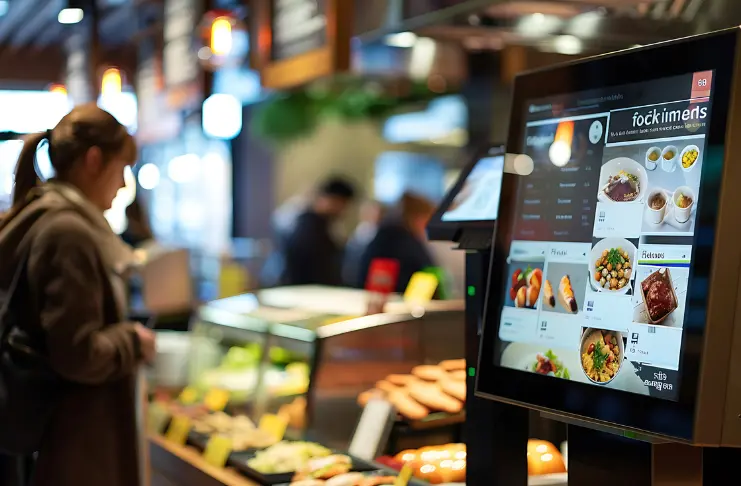
Even with strong demand for dining, high overhead, labor shortages, and rapidly changing consumer habits, leave many Canadian restaurants struggling to stay open past their second year. These pressures don’t affect all operators equally; some navigate tight margins, staffing gaps, and evolving customer expectations successfully, while others close doors within months.
The difference isn’t luck; survival often depends on factors like location, cost management, operational efficiency, and the ability to adapt to shifting consumer preferences. So, understanding these factors and failure rates is essential for anyone invested in the sector.
This blog will explore the key restaurant failure rate statistics in Canada and identify the economic and structural factors that determine which restaurants survive and which do not.
The Reality of Restaurant Failure Rates in Canada
The Canadian restaurant industry is a significant contributor to the economy, with over 79,000 food service businesses nationwide, encompassing full-service restaurants, limited-service establishments, and drinking places.
In 2023, the food service industry achieved operating revenues of approximately $91.6 billion, with full-service restaurants generating $43.6 billion and limited-service eateries, including fast-food outlets, accounting for $41.7 billion.
Despite this substantial economic footprint, the sector faces significant challenges. Recent data indicates that 62% of restaurants are operating at a loss or barely breaking even, a significant increase from 53% in mid-2023. This financial strain has led to an increase in closures, with 719 bankruptcies in the restaurant and accommodation industry in 2023, from 500 in 2022 and 367 in 2021.
The realities of restaurant failures in Canada are no different than the overall industry worldwide. According to the National Restaurant Association, the average failure rate for restaurants stands at 30%, with 17% closing in their first year of operations, and only 34.6% of restaurants survive beyond 10 years of operations.
Key Causes of Restaurant Failure in Canada

Understanding the root causes of restaurant failures is crucial for stakeholders aiming to mitigate risks and capitalize on opportunities within this dynamic sector. Here are the primary factors contributing to restaurant closures in Canada:
1. Financial Mismanagement
Sound financial management is often one of the primary factors that decides the fate of a restaurant. Inflation, in terms of food prices, increased 3% and 5% in 2025, with meat products increasing by 4% to 6%.
At the same time, operating costs have surged, with food costs up 24%, labor costs up 18%, and insurance costs up 24% in Ontario since 2022. Such an increase in costs results in narrower margins for restaurants, requiring tighter inventory management, menu adjustments, and strategic supplier negotiations.
This may also prompt testaurants to delay investments in marketing, technology, or staff development, which can hinder growth and competitiveness. Without effective financial planning and budgeting, even high-traffic establishments may end up facing closures.
2. Labor Shortages and Staffing Challenges
Labor shortages remain one of the most pressing challenges for Canadian restaurants. According to a 2023 Restaurants Canada report, the restaurant sector recorded the highest job vacancy rate of any industry, representing one in six private-sector vacancies nationwide.
Meanwhile, employment levels are still about 175,000 below 2019 benchmarks, leaving many operators short-staffed even as demand rebounds. This talent gap forces restaurants to reduce operating hours, limit menu offerings, or overextend existing staff, which directly affects revenue potential and customer experience.
3. Competitive Market Saturation
Canada’s urban centers, particularly Toronto and Vancouver, face high restaurant density and increasing competition. This saturation makes it challenging for new entrants to differentiate themselves and achieve sustained profitability.
At the same time, the influx of new establishments can lead to market cannibalization, where restaurants vie for the same customer base, often resulting in reduced margins and increased pressure to innovate.
4. Shifting Consumer Behavior
Consumer preferences have evolved, with a growing demand for delivery services, healthier menu options, and digital convenience. Restaurants that fail to adapt to these trends risk losing relevance.
The rise of ghost kitchens and online ordering platforms has further transformed the dining landscape, necessitating that traditional establishments embrace technology to meet customer expectations.
5. Operational Inefficiencies
Operational challenges, including outdated technology and supply chain disruptions, contribute to restaurant failures. Restaurants that rely on legacy systems may struggle with inventory management, order accuracy, and customer engagement.
Additionally, supply chain issues, such as transportation bottlenecks and labor strikes, can lead to inconsistent product availability, affecting menu offerings and customer satisfaction.
6. Regulatory and Compliance Challenges
Navigating the complex regulatory environment poses challenges for restaurant operators. Changes in health and safety regulations, labor laws, and environmental standards require constant adaptation.
Non-compliance can result in fines, legal issues, and reputational damage, underscoring the importance of staying informed and proactive in regulatory matters.
EXPERT OPINION
Alida Solomon, co-owner of a restaurant, Tutti Matt, in downtown Toronto, talks about the growing inflation in the Canadian food service industry. According to her, increasing wages to attract and retain staff is not her biggest problem; inflation is. She says, “Food inflation is over nine per cent. The cost of food plus rent, plus wage increases — which are totally valid, wage increases are normal in the face of inflation — but it’s just the whole package.”
She adds, “We used to have people that would come every single day for lunch, but we’ve changed our hours of operation — we’re no longer open five days a week for lunch, we’re actually only open three because we found that Mondays and Tuesdays were just not working for us.”
The Role of Economic Conditions in Restaurant Failure Rates
While operational strategies and market positioning impact your odds of survival, broader economic forces often set the playing field. Understanding how these macroeconomic conditions impact daily operations is essential for restaurant operators to ensure success-
A. Inflation and Rising Food Costs
In 2025, 85% of Canadian restaurants identified inflation as a key challenge, reflecting the real strain on profit margins from rising food prices and operational expenses. Even small increases in ingredient or utility costs can quickly erode profitability, making careful cost management essential for survival.
B. Interest Rates and Economic Cycles
The Bank of Canada recently lowered its key policy interest rate to 2.5%, the lowest in three years, aiming to encourage spending amid a slowing economy and the highest unemployment in nearly a decade.
These shifts influence consumer dining behavior and investment decisions, and restaurants must anticipate slower traffic or tighter budgets when rates fluctuate.
C. Provincial Wage Laws and Labor Availability
Rising wage laws across Canada are reshaping how restaurants manage labor costs. While higher pay supports workers, it also means the margins for operators decrease amidst rising inflation and rents.
In Nova Scotia, for example, the 2025 minimum wage increase has raised concerns among foodservice businesses, with industry groups warning that without tax relief, many operators may be forced to reduce staff hours or scale back hiring.
Combined with ongoing labor shortages in multiple provinces, these pressures make it increasingly difficult for restaurants to maintain full-service levels while staying financially sustainable.
D. Fluctuating Tourism-Driven Revenue
Seasonal reliance is another factor that shapes restaurant survival in Canada. Operators in tourism-heavy regions often see strong peaks during summer or winter but face sharp downturns in the off-season.
For perspective, two-thirds of tourism businesses in 2025 expect flat or declining revenue despite rising operating costs. This volatility makes it harder for restaurants to maintain consistent staffing, manage inventory, and cover fixed expenses year-round.

Technological Trends for Operational Success
1. Point-of-Sale (POS) Systems with Integrated Analytics
The Canadian POS software market is projected to grow at a CAGR of 7.0% from 2025 to 2032, reflecting the increasing adoption of these systems.
When it comes to running a restaurant, modern POS systems offer the tools you need to record and manage sales, inventory, menus, labor, and more. You can easily track performance in real time and spot problems before they cut into margins.
This way, POS systems allow Canadian restaurant owners to make data-driven decisions, optimizing pricing strategies and reducing waste.
2. Digital Ordering and Delivery Platforms
With 56% of Canadian consumers preferring to order food online through third-party apps, more restaurants are relying on platforms like Uber Eats and DoorDash to expand their reach. These platforms not only help increase sales but also provide valuable customer insights, promoting personalized marketing efforts.
3. AI-Driven Automation
AI-driven automation is increasingly helping restaurants manage one of their toughest challenges: operational inefficiency. From predictive inventory management and smart order forecasting to kitchen workflow optimization and simplified payments, these tools reduce errors, save time, and cut costs.
And the impact is evident — restaurants employing automation can cut up to 25% in labor costs, reduce cooking time by 30%, and minimize waste by 10-15%.

4. Self-Service Kiosks and Digital Menus
Digital menus and self-service kiosks give customers more control over their orders, reducing errors and speeding up service. At the same time, they guide guests toward add-ons or premium options, which can raise average order values.
Restaurants using these systems report increases of 12% to 20% per transaction, demonstrating how technology can directly boost revenue while improving the guest experience.
5. Inventory Management Systems with Predictive Analytics
Advanced inventory management systems use predictive analytics to forecast demand, minimizing stockouts and overstock situations. By automating reordering processes, these systems help maintain optimal inventory levels, reducing food waste and ensuring consistent menu offerings.
Conclusion
Understanding why restaurants in Canada fail is only part of the picture; you also need to act on that knowledge. In addition to managing costs and staffing, restaurants must continuously review customer demands, adapt to local market shifts, and experiment with operational improvements.
This might mean rethinking menu structures based on sales patterns, introducing flexible service models during slow seasons, or using data to anticipate demand fluctuations. By treating these failure statistics as guiding numbers, restaurant owners can make smarter decisions that protect profits, improve customer experience, and help their business grow.
Frequently Asked Questions
Globally, around 30% of restaurants close within the first three years. The failure rate slows over time, but many restaurants struggle to reach the five-year mark due to high overheads and operational challenges.
No, the belief that 90% restaurants fail is a myth. Recent data shows that roughly 30% of restaurants close within three years, and about 83% survive the first year, making total failure far lower than 90%.
On average, about 50–60% of restaurants fail within five years, with failure often linked to poor financial management, intense competition, and shifting consumer preferences.
The success rate of restaurant ownership is roughly 50% past the five-year mark. Success is closely tied to strong financial planning, location strategy, and operational efficiency.








